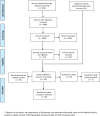First and second trimester ultrasound in pregnancy: A systematic review and metasynthesis of the views and experiences of pregnant women, partners, and health workers
- PMID: 34905561
- PMCID: PMC8670688
- DOI: 10.1371/journal.pone.0261096
First and second trimester ultrasound in pregnancy: A systematic review and metasynthesis of the views and experiences of pregnant women, partners, and health workers
Abstract
Background: The World Health Organization (WHO) recommends one ultrasound scan before 24 weeks gestation as part of routine antenatal care (WHO 2016). We explored influences on provision and uptake through views and experiences of pregnant women, partners, and health workers.
Methods: We undertook a systematic review (PROSPERO CRD42021230926). We derived summaries of findings and overarching themes using metasynthesis methods. We searched MEDLINE, CINAHL, PsycINFO, SocIndex, LILACS, and AIM (Nov 25th 2020) for qualitative studies reporting views and experiences of routine ultrasound provision to 24 weeks gestation, with no language or date restriction. After quality assessment, data were logged and analysed in Excel. We assessed confidence in the findings using Grade-CERQual.
Findings: From 7076 hits, we included 80 papers (1994-2020, 23 countries, 16 LICs/MICs, over 1500 participants). We identified 17 review findings, (moderate or high confidence: 14/17), and four themes: sociocultural influences and expectations; the power of visual technology; joy and devastation: consequences of ultrasound findings; the significance of relationship in the ultrasound encounter. Providing or receiving ultrasound was positive for most, reportedly increasing parental-fetal engagement. However, abnormal findings were often shocking. Some reported changing future reproductive decisions after equivocal results, even when the eventual diagnosis was positive. Attitudes and behaviours of sonographers influenced service user experience. Ultrasound providers expressed concern about making mistakes, recognising their need for education, training, and adequate time with women. Ultrasound sex determination influenced female feticide in some contexts, in others, termination was not socially acceptable. Overuse was noted to reduce clinical antenatal skills as well as the use and uptake of other forms of antenatal care. These factors influenced utility and equity of ultrasound in some settings.
Conclusion: Though antenatal ultrasound was largely seen as positive, long-term adverse psychological and reproductive consequences were reported for some. Gender inequity may be reinforced by female feticide following ultrasound in some contexts. Provider attitudes and behaviours, time to engage fully with service users, social norms, access to follow up, and the potential for overuse all need to be considered.
Conflict of interest statement
The authors have declared that no competing interests exist.
Similar articles
-
Provision and uptake of routine antenatal services: a qualitative evidence synthesis.Cochrane Database Syst Rev. 2019 Jun 12;6(6):CD012392. doi: 10.1002/14651858.CD012392.pub2. Cochrane Database Syst Rev. 2019. PMID: 31194903 Free PMC article.
-
Folic acid supplementation and malaria susceptibility and severity among people taking antifolate antimalarial drugs in endemic areas.Cochrane Database Syst Rev. 2022 Feb 1;2(2022):CD014217. doi: 10.1002/14651858.CD014217. Cochrane Database Syst Rev. 2022. PMID: 36321557 Free PMC article.
-
Midwives' experiences of performing obstetric ultrasounds in antenatal care in eastern Ethiopia: Qualitative exploratory study.Womens Health (Lond). 2024 Jan-Dec;20:17455057241228135. doi: 10.1177/17455057241228135. Womens Health (Lond). 2024. PMID: 38366806 Free PMC article.
-
Antenatal Doppler ultrasound implementation in a rural sub-Saharan African setting: exploring the perspectives of women and healthcare providers.Reprod Health. 2021 Oct 7;18(1):199. doi: 10.1186/s12978-021-01233-5. Reprod Health. 2021. PMID: 34620186 Free PMC article.
-
What matters to women: a systematic scoping review to identify the processes and outcomes of antenatal care provision that are important to healthy pregnant women.BJOG. 2016 Mar;123(4):529-39. doi: 10.1111/1471-0528.13819. Epub 2015 Dec 24. BJOG. 2016. PMID: 26701735
Cited by
-
Benefits and harms of antenatal and newborn screening programmes in health economic assessments: the VALENTIA systematic review and qualitative investigation.Health Technol Assess. 2024 Jun;28(25):1-180. doi: 10.3310/PYTK6591. Health Technol Assess. 2024. PMID: 38938110 Free PMC article.
-
Strengthening antenatal care services for all: implementing imaging ultrasound before 24 weeks of pregnancy.BMJ Glob Health. 2023 May;8(5):e011170. doi: 10.1136/bmjgh-2022-011170. BMJ Glob Health. 2023. PMID: 37257940 Free PMC article. No abstract available.
-
Assessing the Quality of Antenatal Care in King Abdulaziz University Hospital: A Retrospective Study.Cureus. 2023 Apr 5;15(4):e37150. doi: 10.7759/cureus.37150. eCollection 2023 Apr. Cureus. 2023. PMID: 37153298 Free PMC article.
-
Evidence that prenatal care visit experiences influence perceptions of the child.Commun Psychol. 2025 May 5;3(1):73. doi: 10.1038/s44271-025-00256-z. Commun Psychol. 2025. PMID: 40325164 Free PMC article.
-
A survey of obstetric ultrasound uses and priorities for artificial intelligence-assisted obstetric ultrasound in low- and middle-income countries.Sci Rep. 2025 Jan 31;15(1):3873. doi: 10.1038/s41598-025-87284-1. Sci Rep. 2025. PMID: 39890863 Free PMC article.
References
-
- Goley SM, Sakula-Barry S, Adofo-Ansong N, et al.. Investigating the use of ultrasonography for the antenatal diagnosis of structural congenital anomalies in low-income and middle-income countries: a systematic review. BMJ Paediatr Open. 2020; 4: e000684. doi: 10.1136/bmjpo-2020-000684 - DOI - PMC - PubMed
-
- World Health Organisation. WHO Recommendations on Antenatal Care for a Positive Pregnancy Experience; 2016. - PubMed
Publication types
MeSH terms
Grants and funding
LinkOut - more resources
Full Text Sources


